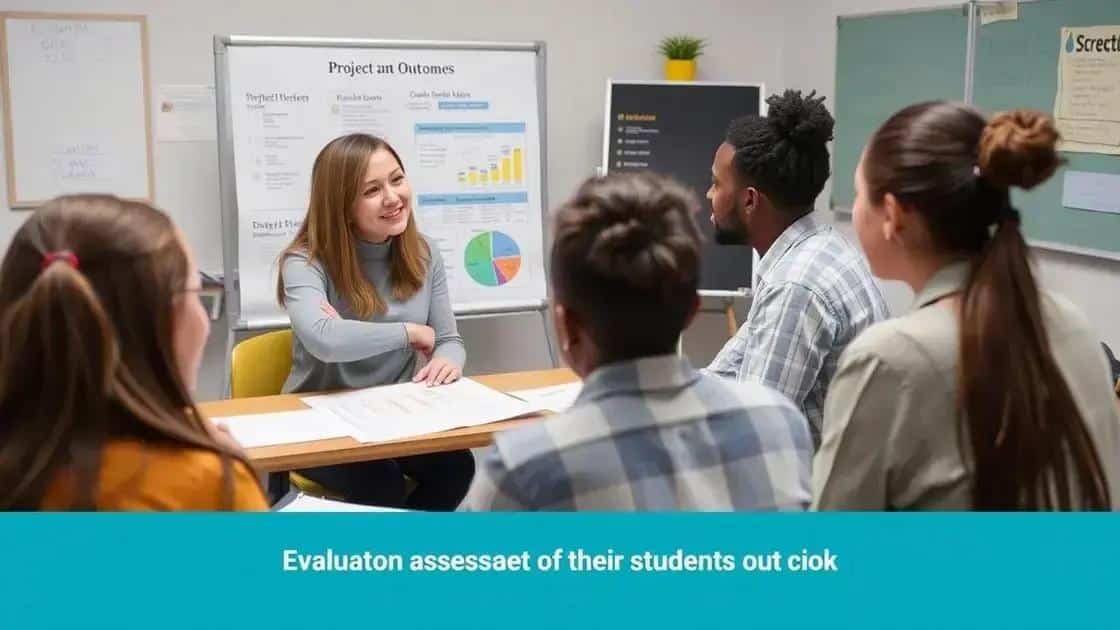Project-based learning outcomes evaluation: enhancing engagement

Evaluating the effectiveness of project-based assessments involves defining clear objectives, utilizing diverse methods, providing continuous feedback, and engaging students in the evaluation process to enhance learning outcomes.
Project-based learning outcomes evaluation offers a fresh perspective on student assessments, pushing away from traditional methods. Have you considered how these evaluations can transform educational experiences?
Understanding project-based learning
Understanding project-based learning is essential for teachers and students alike. This method emphasizes real-world challenges and hands-on experiences, making learning more engaging and effective. When students work on projects, they not only acquire knowledge but also develop critical skills.
The Benefits of Project-Based Learning
This approach offers several advantages:
- Enhances collaboration among students.
- Encourages problem-solving and critical thinking.
- Improves retention of knowledge through practical application.
By embedding project-based learning into the curriculum, educators create an environment where students can thrive. They become active participants in their education rather than passive recipients of information. It’s vital to recognize the difference this can make in student engagement and success.
How It Works
In project-based learning, students tackle real-world problems or questions, working in teams to find solutions. This process fosters a sense of ownership and responsibility among learners. They explore topics more deeply through research and collaboration, sharpening their skills along the way.
Teachers act as facilitators, guiding students through the learning process. They provide the resources and support needed for effective exploration without directly giving answers. This dynamic promotes independence, allowing students to take charge of their learning journey.
Overall, a well-structured project-based learning framework helps students apply what they’ve learned in meaningful ways. By engaging them in tasks that reflect real life, we can spark their interest and motivate them to learn more, ultimately preparing them for future challenges.
Key outcomes of project-based learning

Understanding the key outcomes of project-based learning is crucial for educators seeking to enhance student engagement and success. This method not only fosters knowledge acquisition but also builds essential skills that students will use throughout their lives.
Essential Skills Developed
One major outcome is the development of critical thinking skills. Students learn to analyze problems, weigh solutions, and make informed decisions. Additionally, they enhance their collaboration abilities while working in teams, which prepares them for future workplace dynamics.
- Problem-solving: Students tackle real-world issues, increasing their analytical skills.
- Communication: Engaging with peers and presenting ideas builds strong verbal and written communication abilities.
- Creativity: Project-based learning allows students to think creatively, fostering innovation.
Moreover, students increase their intrinsic motivation when they see the real-world relevance of their projects. This engagement leads to improved retention of knowledge, as students apply what they learn to practical situations. By focusing on hands-on learning, educators can help students connect theories to real-life applications.
Improvement in Academic Performance
Studies have shown that students engaged in project-based learning often achieve better academic outcomes compared to those in traditional settings. They not only perform well on assessments but also develop a deeper understanding of the subject matter.
Effective project-based learning also cultivates a growth mindset. Students learn that challenges are part of the learning process, encouraging persistence and resilience. This mindset proves beneficial not just in academics, but in all aspects of life.
As educators integrate project-based learning into their teaching strategies, they can expect to see remarkable transformations in student engagement, creativity, and overall academic success. Aligning assessments with these outcomes further enhances the effectiveness of this teaching approach.
Evaluating the effectiveness of project-based assessments
Evaluating the effectiveness of project-based assessments is crucial to understanding how well students are learning. These assessments not only measure knowledge but also assess essential skills such as collaboration and critical thinking.
Key Evaluation Criteria
When evaluating project-based assessments, it’s important to consider several key criteria:
- Alignment with Learning Goals: Ensure assessments align with the desired educational outcomes.
- Student Engagement: Assess how engaged students are during the project.
- Diversity of Skills: Evaluate how well projects allow students to demonstrate various skills.
Using these criteria helps educators gauge the effectiveness of their assessments. Moreover, feedback from students can provide insights into what worked well and what could be improved.
Data Collection Methods
There are various methods for collecting data on the effectiveness of project-based assessments. Surveys can help gather student opinions on their learning experiences. Observations during projects can provide valuable insights into student engagement and collaboration.
Another approach is to analyze the products that students create. Projects often result in tangible outcomes, such as presentations or reports. Evaluating these deliverables can reveal how well students understand the material and can apply their knowledge in real-world contexts.
Additionally, self-assessments allow students to reflect on their learning process, fostering a sense of ownership. This kind of reflection not only enhances learning but also encourages personal growth.
By combining various evaluation methods, educators can gain a comprehensive view of how effective project-based assessments are in fostering student learning and engagement. Understanding these aspects ultimately leads to improved instructional strategies.
Best practices for outcome evaluation

When it comes to outcome evaluation, applying best practices can significantly enhance the effectiveness of the assessment process. These practices ensure that evaluations are fair, comprehensive, and insightful.
Defining Clear Objectives
One of the first steps in effective evaluation is to define clear, measurable objectives. These objectives should align with the overall goals of the project-based learning initiative. Having defined goals helps guide the evaluation process.
- Specificity: Objectives should be specific and detailed.
- Measurability: Ensure that outcomes can be quantified or qualitatively assessed.
- Relevance: Make sure goals meet the needs of students and stakeholders.
With clear objectives, evaluating the effectiveness of the learning process becomes much more straightforward.
Incorporating Diverse Evaluation Methods
Using a variety of evaluation methods can provide a well-rounded view of student performance. Different methods serve to capture different aspects of learning. For instance, you might consider:
- Peer assessments: Allowing students to evaluate each other’s work promotes critical thinking.
- Self-reflections: Encouraging students to assess their own progress fosters ownership of learning.
- Performance tasks: Providing hands-on tasks helps evaluate applied skills.
By combining these methods, educators can gather a more comprehensive set of data on student outcomes and improve future learning experiences.
Continuous feedback is another best practice in outcome evaluation. Frequent feedback helps students understand their strengths and areas for improvement. This ongoing dialogue supports their growth and learning journey. It also allows educators to adjust their teaching strategies based on real-time data.
Lastly, involving students in the evaluation process can enhance engagement. When students participate actively in the evaluation discussion, they are more likely to take ownership of their learning and outcomes.
FAQ – Frequently Asked Questions about Evaluating Project-Based Learning Outcomes
What are the key components of effective outcome evaluation?
Effective outcome evaluation includes defining clear objectives, using diverse evaluation methods, and providing continuous feedback.
How can student involvement improve evaluation processes?
When students participate in the evaluation process, they take ownership of their learning, which can enhance engagement and motivation.
What methods can be used for evaluating project-based assessments?
Methods include peer assessments, self-reflections, performance tasks, and direct observation during projects.
Why is continuous feedback important in project-based learning?
Continuous feedback helps students understand their progress, fosters improvement, and allows educators to adjust teaching methods as needed.





